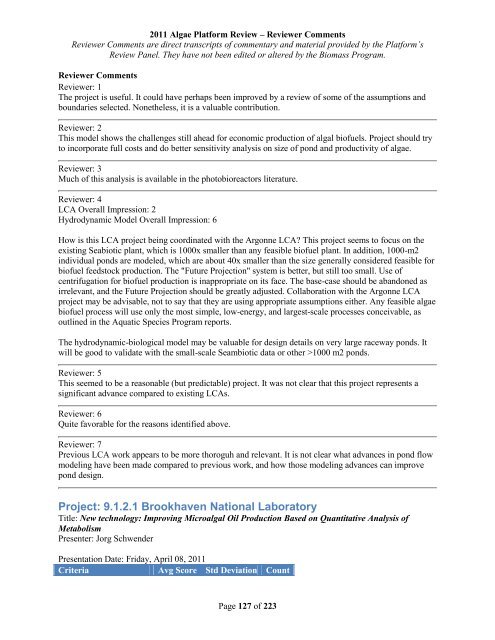Reviewer Comments - EERE
Reviewer Comments - EERE
Reviewer Comments - EERE
You also want an ePaper? Increase the reach of your titles
YUMPU automatically turns print PDFs into web optimized ePapers that Google loves.
2011 Algae Platform Review – <strong>Reviewer</strong> <strong>Comments</strong><br />
<strong>Reviewer</strong> <strong>Comments</strong> are direct transcripts of commentary and material provided by the Platform’s<br />
Review Panel. They have not been edited or altered by the Biomass Program.<br />
<strong>Reviewer</strong> <strong>Comments</strong><br />
<strong>Reviewer</strong>: 1<br />
The project is useful. It could have perhaps been improved by a review of some of the assumptions and<br />
boundaries selected. Nonetheless, it is a valuable contribution.<br />
<strong>Reviewer</strong>: 2<br />
This model shows the challenges still ahead for economic production of algal biofuels. Project should try<br />
to incorporate full costs and do better sensitivity analysis on size of pond and productivity of algae.<br />
<strong>Reviewer</strong>: 3<br />
Much of this analysis is available in the photobioreactors literature.<br />
<strong>Reviewer</strong>: 4<br />
LCA Overall Impression: 2<br />
Hydrodynamic Model Overall Impression: 6<br />
How is this LCA project being coordinated with the Argonne LCA? This project seems to focus on the<br />
existing Seabiotic plant, which is 1000x smaller than any feasible biofuel plant. In addition, 1000-m2<br />
individual ponds are modeled, which are about 40x smaller than the size generally considered feasible for<br />
biofuel feedstock production. The "Future Projection" system is better, but still too small. Use of<br />
centrifugation for biofuel production is inappropriate on its face. The base-case should be abandoned as<br />
irrelevant, and the Future Projection should be greatly adjusted. Collaboration with the Argonne LCA<br />
project may be advisable, not to say that they are using appropriate assumptions either. Any feasible algae<br />
biofuel process will use only the most simple, low-energy, and largest-scale processes conceivable, as<br />
outlined in the Aquatic Species Program reports.<br />
The hydrodynamic-biological model may be valuable for design details on very large raceway ponds. It<br />
will be good to validate with the small-scale Seambiotic data or other >1000 m2 ponds.<br />
<strong>Reviewer</strong>: 5<br />
This seemed to be a reasonable (but predictable) project. It was not clear that this project represents a<br />
significant advance compared to existing LCAs.<br />
<strong>Reviewer</strong>: 6<br />
Quite favorable for the reasons identified above.<br />
<strong>Reviewer</strong>: 7<br />
Previous LCA work appears to be more thoroguh and relevant. It is not clear what advances in pond flow<br />
modeling have been made compared to previous work, and how those modeling advances can improve<br />
pond design.<br />
Project: 9.1.2.1 Brookhaven National Laboratory<br />
Title: New technology: Improving Microalgal Oil Production Based on Quantitative Analysis of<br />
Metabolism<br />
Presenter: Jorg Schwender<br />
Presentation Date: Friday, April 08, 2011<br />
Criteria Avg Score Std Deviation Count<br />
Page 127 of 223




